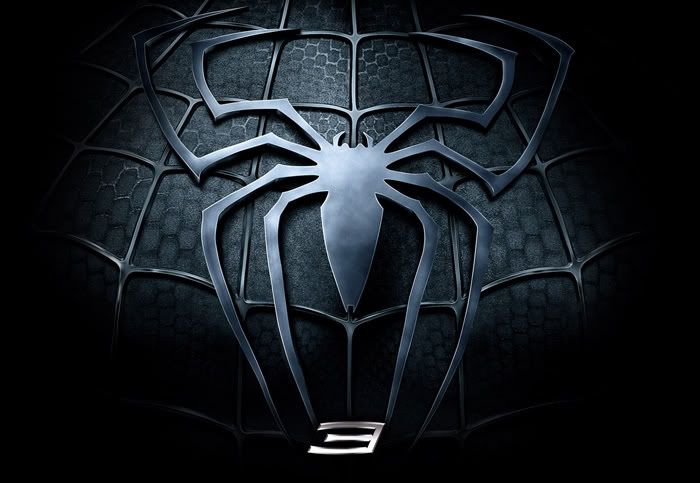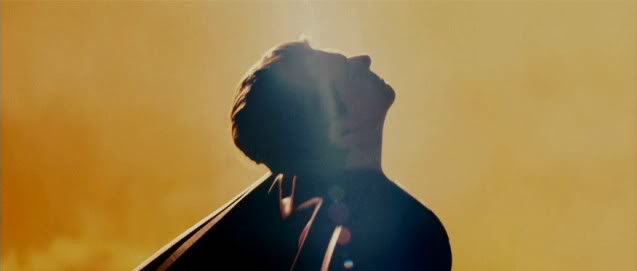Some brief thoughts on Spiderman 3, comix, and film.

Spiderman, the hero, has incredible balance and poise, an ability to maneuver any which way he pleases at any moment. He defies physics at all times. Somehow, he's able to swing past multiple city-blocks from the top of skyscrapers down through traffic and back up again all on one web. And then he shoots some more goo and flies further, a lithe spectre slinging his way across the sky, around buildings, through alleys, dodging life. Sam Raimi's newest Spiderman film, the third installment in an ever-expanding series, isn't too dissimilar from its predecessors and not quite as nimble as its hero, despite a lot of swooshing, slashing camera moves: it's a little bloated, a lot silly, and, perhaps, a perfect rendition of comix on a film screen. Whether or not that perfect rendition satisfies you is another story. It's got the visual chops, sure, as there are bright, popping colors filling every corner of the frame and wild camera angles to frame the action. Raimi is at once a brilliant penciler and inker and colorist: the Spiderman films are beauties, made to be seen large, in a theatre. However, to behold an image is different from reading an image, or series of images. Comics are, basically, a series of images linked together to tell a story, just as film is, primarily, a visual medium. Yet one rarely reads a comic, even a good comic, for its writing. Good comic writing is pretty simple stuff, even in "classic" books like Watchmen. Good film writing, which includes not just dialogue and character but camera movements and editing, is a much more difficult, or complex, networked assembly. And, more often than not, there is better, or more complex, writing in films.
Wait a sec, there, Ry-Guy! Are you saying comix suck?
Well, no. I just don't care for them the same. I can no longer appreciate what they have to offer other than their artwork. The words in a comic rarely delight me. One of my favorite comix, to this day, is the Sin City one-off book called "Silent Night",
 which has no dialogue bubbles nor any narration commentary but rather 15 pages of blissful Frank Miller black-and-white ink art. Being silent, it lent the book a tenderness Miller's work so rarely engages. In re-reading my Sin City books before Robert Rodriguez literalized the series on (digital) film, I was struck by how cruel a world Miller had built. And the film was yet more cruel, which is my primary reason for hating its guts. That, and, as is my problem with the Spiderman films, it doesn't do anything filmic. All either film does is transfer a comic's celled images into free and continuous images without adding anything new, really, except maybe the delight of casting; in Sin City it's Mickey Rourke, in Spiderman it's any of the villians (Willem Defoe, Alfred Molina, Thomas Hayden Church, even Topher Grace). The thing that makes the Spiderman movies a little more bearable than Sin City is Raimi's unabashed melodrama, which, somehow, despite his poor skill with actors these days, renders some true pathos, shows some true heart. Plus, the special effects are good. And there's an occasional moment of poetry, a hint at what movies could do, and have done, with superhero stories.
which has no dialogue bubbles nor any narration commentary but rather 15 pages of blissful Frank Miller black-and-white ink art. Being silent, it lent the book a tenderness Miller's work so rarely engages. In re-reading my Sin City books before Robert Rodriguez literalized the series on (digital) film, I was struck by how cruel a world Miller had built. And the film was yet more cruel, which is my primary reason for hating its guts. That, and, as is my problem with the Spiderman films, it doesn't do anything filmic. All either film does is transfer a comic's celled images into free and continuous images without adding anything new, really, except maybe the delight of casting; in Sin City it's Mickey Rourke, in Spiderman it's any of the villians (Willem Defoe, Alfred Molina, Thomas Hayden Church, even Topher Grace). The thing that makes the Spiderman movies a little more bearable than Sin City is Raimi's unabashed melodrama, which, somehow, despite his poor skill with actors these days, renders some true pathos, shows some true heart. Plus, the special effects are good. And there's an occasional moment of poetry, a hint at what movies could do, and have done, with superhero stories. In his generous review of Spiderman 3, my sometimes-editor Matt Zoller Seitz points to Superman Returns "as the most mature, emotionally complex, morally serious superhero movie yet made." Not to mention poetic, and devastating. It's routinely railed against for being boring and confusing but I'd like to side with MZS and say, hey, stop a second and take a look at what a great film this is, not simply a comic book movie. As I said in my first, rough, silly stab at a movie review on this blog, it's Bryan Singer who makes the film work. Everything in that film is a risk, and I'd like to say the risks pay off. Raimi's attempts to risk, to stretch himself -- and his film -- rarely work as well, if ever. At one point, in an effort to show how hard it is for Peter Parker... to live? to cry? to sit? Raimi holds a shot a lot longer than he should: Tobey Maguire sits on the end of his bed, erect, with his eyes bubbling up with tears and his face almost too serene, and Raimi moves the camera from low across the room all the way in front of Maguire's doughy face, and then around it, almost all the way behind Maguire's head. I couldn't stop laughing for the entire shot. Who does that?
In his generous review of Spiderman 3, my sometimes-editor Matt Zoller Seitz points to Superman Returns "as the most mature, emotionally complex, morally serious superhero movie yet made." Not to mention poetic, and devastating. It's routinely railed against for being boring and confusing but I'd like to side with MZS and say, hey, stop a second and take a look at what a great film this is, not simply a comic book movie. As I said in my first, rough, silly stab at a movie review on this blog, it's Bryan Singer who makes the film work. Everything in that film is a risk, and I'd like to say the risks pay off. Raimi's attempts to risk, to stretch himself -- and his film -- rarely work as well, if ever. At one point, in an effort to show how hard it is for Peter Parker... to live? to cry? to sit? Raimi holds a shot a lot longer than he should: Tobey Maguire sits on the end of his bed, erect, with his eyes bubbling up with tears and his face almost too serene, and Raimi moves the camera from low across the room all the way in front of Maguire's doughy face, and then around it, almost all the way behind Maguire's head. I couldn't stop laughing for the entire shot. Who does that?But Spiderman 3 is occasionally, if briefly, inspired. Its most poetic moment comes in the climactic battle. The ever-gooier Venom's one weakness is sound. Loud, reverberating sound. So Peter Parker starts making some noise. He builds a cage of sound around Venom and rings it out, crushing Venom under a wall of sound waves. And then he blows him up. It's a cool moment. But then people start talking again. And then the score starts swelling again. And then the best metaphor in the film -- Sandman
 's very being is ephemerally mutable, like time, like sand in an hourglass, which visually manifests time -- is wasted once again by virtue of the hackneyed dialogue and what-are-you-thinking-writing/directing/acting. A colleague said, "It's like Raimi's a no-talent Hitchcock. He's got the visual style but no brains behind it. Watching [the Spiderman movies] is kinda like when you buy candy bars 3-for-1 after school. They taste alright but you come to realize, wait, that did nothing for me, for my body, for my soul." I'm apt to agree.
's very being is ephemerally mutable, like time, like sand in an hourglass, which visually manifests time -- is wasted once again by virtue of the hackneyed dialogue and what-are-you-thinking-writing/directing/acting. A colleague said, "It's like Raimi's a no-talent Hitchcock. He's got the visual style but no brains behind it. Watching [the Spiderman movies] is kinda like when you buy candy bars 3-for-1 after school. They taste alright but you come to realize, wait, that did nothing for me, for my body, for my soul." I'm apt to agree.




Raimi is more a cartoonist than a filmmaker, always has been. But the depth of S2 gave me hope for S3. A big let down. What will Sam do next? Let's hope he doesn't try a Frank Miller assignment!
ReplyDelete